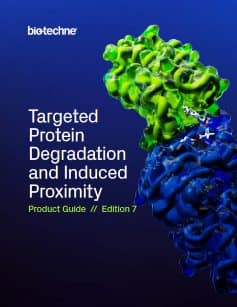Functionalized Warhead Ligands
Building Blocks |
|
| Cat. No. | Product Name / Activity |
|---|---|
| 7689 | (+)-JQ1 bump, acid functionalized |
| Functionalized BET bromodomain ligand; precursor for Tag Degraders | |
| 7576 | (+)-JQ1 maleimide |
| JQ1-maleimide functionalized probe; induces proteasomal degradation of BRD4 | |
Literature for Functionalized Warhead Ligands
Tocris offers the following scientific literature for Functionalized Warhead Ligands to showcase our products. We invite you to request* your copy today!
*Please note that Tocris will only send literature to established scientific business / institute addresses.
TPD and Induced Proximity Research Product Guide
This brochure highlights the tools and services available from Bio-Techne to support your Targeted Protein Degradation and Induced Proximity research, including:
- Active Degraders
- TAG Degradation Platform
- Degrader Building Blocks
- Assays for Protein Degradation
- Induced Proximity Tools
Developing Degraders Poster
This poster describes the generation of a database of Degraders (PROTACs®) from the literature. The Degraders were profiled according to the constituent ligands, linker type, linker length and physicochemical properties and this information was used to establish a set of guidelines for the design and synthesis of cell-permeable Degrader molecules. Presented at the 20th SCI/RSC Medicinal Chemistry Symposium 2019, Cambridge, UK.PROTAC® is a registered trademark of Arvinas Operations, Inc., and is used under license.
Targeted Protein Degradation Poster
Degraders (e.g. PROTACs) are bifunctional small molecules, that harness the Ubiquitin Proteasome System (UPS) to selectively degrade target proteins within cells. They consist of three covalently linked components: an E3 ubiquitin ligase ligand, a linker and a ligand for the target protein of interest. Authored in-house, this poster outlines the generation of a toolbox of building blocks for the development of Degraders. The characteristics and selection of each of these components are discussed. Presented at EFMC 2018, Ljubljana, Slovenia


